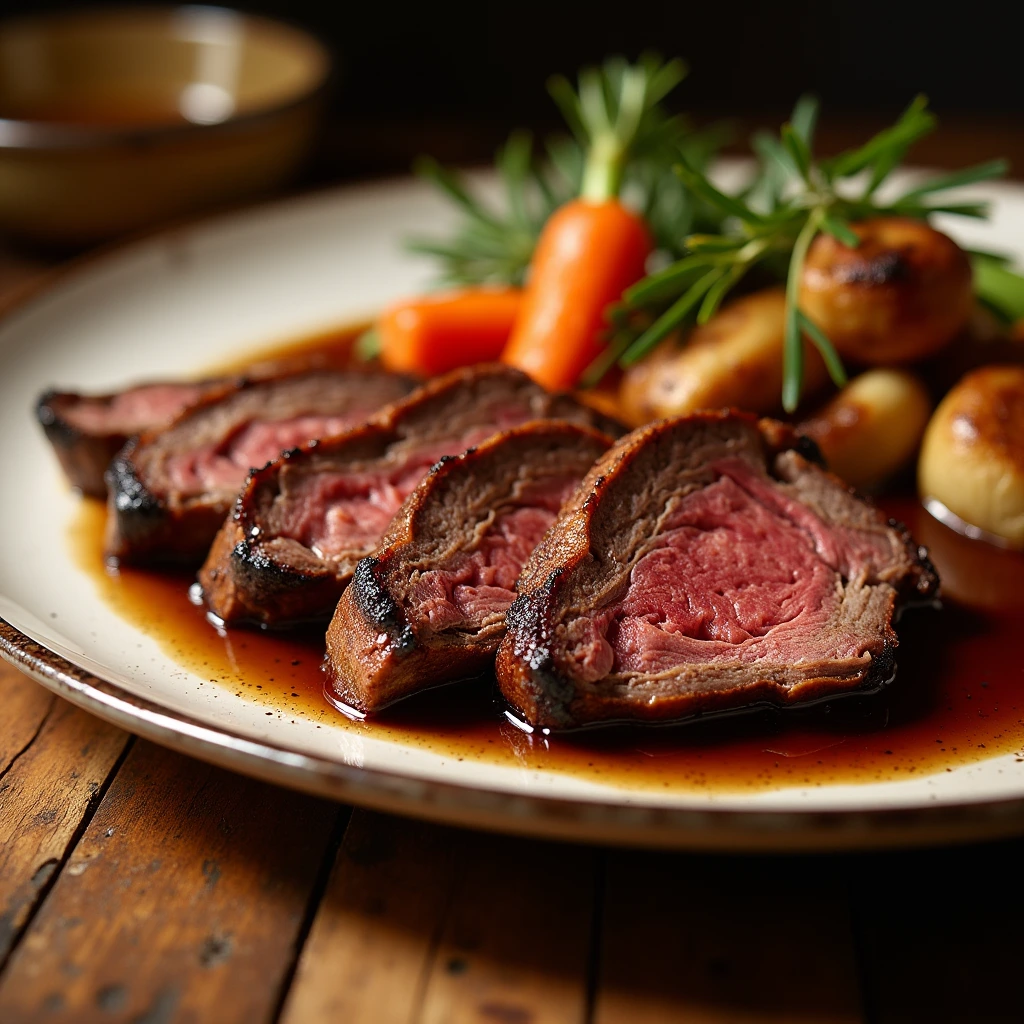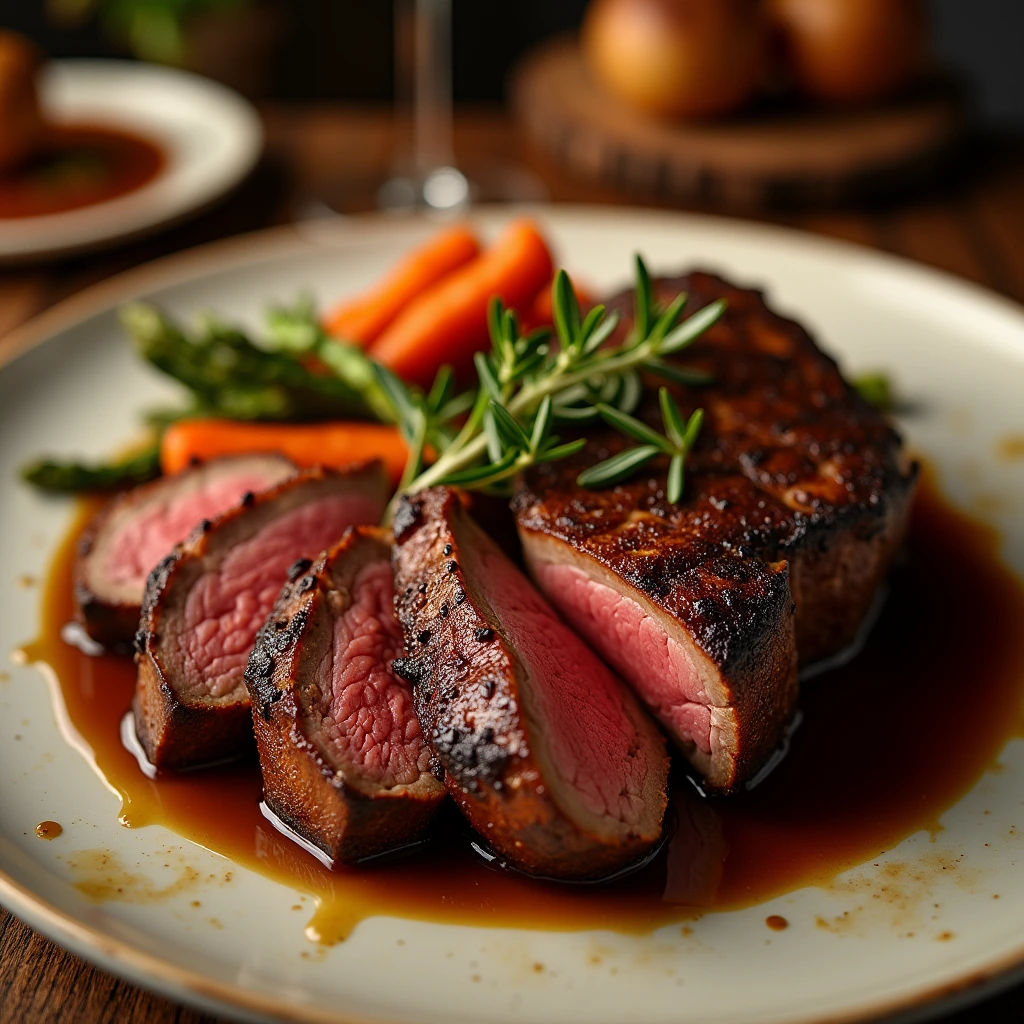Prime rib is a dish that brings a sense of luxury, perfect for celebrating special moments. Its tender texture and rich flavor make it a favorite for gatherings. When paired with au jus—a light sauce made from its own juices—it becomes even more delicious, highlighting the meat’s natural taste.
This recipe is simple yet impressive, making it ideal for holidays, parties, or a fancy meal at home. You don’t need to be a chef to create a tender, juicy roast that will wow your guests. With just a few easy steps, you can enjoy a restaurant-style meal right in your kitchen. It’s the perfect way to make any occasion unforgettable!

Understanding Prime Rib Au Jus Recipe
Prime rib, also called a standing rib roast, is a tender and flavorful cut of beef. Taken from the rib section, it’s known for its rich marbling, which creates a juicy and buttery texture. This cut is a favorite for special occasions and a guaranteed crowd-pleaser.
There are two main types of cuts. A bone-in roast includes the ribs, adding flavor and helping the meat stay tender while cooking. A boneless roast is easier to carve but still offers great taste.
When choosing a rib roast, pay attention to the meat grade. USDA Prime has the best marbling and flavor, while USDA Choice offers good quality at a lower cost. Look for firm meat with a bright red color and creamy white fat.
Prime rib is versatile, making it perfect for small dinners or large gatherings. With its rich flavor and simple preparation, it’s always a hit.
Preparing the Ingredients for Prime Rib Au Jus Recipe
To make a perfect prime rib and au jus, you’ll need a few essential ingredients. For the prime rib, gather a high-quality rib roast, salt, pepper, garlic, and fresh herbs like rosemary and thyme. Additionally, for the au jus, you’ll need beef stock, pan drippings, and a touch of red wine or Worcestershire sauce to enhance the flavor.
When selecting fresh ingredients, it’s important to focus on quality. For instance, choose a rib roast with a bright red color and creamy white marbling. Ideally, opt for USDA Prime or Choice grades for the best results. Furthermore, look for herbs that are fragrant and free of wilted leaves. Similarly, when buying garlic, pick firm, dry bulbs with tight skins.
As for the beef stock, homemade or low-sodium options are best because they allow you to control the saltiness. If you’re using wine, select a dry red variety that you enjoy drinking. By carefully choosing fresh, high-quality ingredients, you ensure your dish is flavorful, balanced, and worthy of any special occasion.
Preparing the Prime Rib
Preparing the prime rib is the foundation for a flavorful and tender roast. Start by generously seasoning the rib roast with salt, pepper, and minced garlic. For added aroma, rub it with fresh herbs like rosemary and thyme. Let the roast sit at room temperature for about an hour to ensure even cooking.
Achieving a perfect crust requires a two-step process. Begin by roasting the meat at a low temperature to cook it gently. Then, finish with a high-heat blast in the oven to create a golden, crispy exterior. This reverse-sear technique locks in the juices while delivering a beautifully caramelized crust.
After cooking, it’s crucial to let the roast rest for at least 20 minutes. This allows the juices to redistribute, keeping the meat moist and tender when sliced. Tent the roast lightly with foil during this time to retain warmth. Proper seasoning, a perfect crust, and sufficient resting ensure your prime rib is a show-stopping centerpiece for any meal.
Cooking Techniques of Prime Rib Au Jus Recipe
Choosing the right cooking technique is key to making a perfect prime rib. Two popular methods are slow roasting and the high heat method. Slow roasting cooks the meat evenly at a low temperature, resulting in a tender, juicy interior. On the other hand, the high heat method sears the exterior first, creating a crispy crust, but it requires careful monitoring to avoid overcooking.
Using a meat thermometer is essential to achieve your desired doneness. Insert the thermometer into the thickest part of the roast, avoiding the bone. This ensures an accurate reading, so you know when to remove the meat from the oven.
Cooking times vary depending on the doneness level. For rare, aim for an internal temperature of 120°F (48°C); for medium rare, 130°F (54°C); and for medium, 140°F (60°C). Remember, the roast continues to cook while resting, so remove it from the oven 5–10°F before reaching the target temperature.
Whether you prefer slow roasting or the high heat method, combining precise cooking techniques with a meat thermometer ensures a perfectly cooked prime rib every time.
Crafting the Au Jus
Au jus is a light, savory sauce made from the natural juices of roasted meat. This classic accompaniment enhances the flavor of prime rib without overpowering its rich taste. It’s simple to prepare and adds a gourmet touch to your dish.
To make au jus, you’ll need a few basic ingredients: pan drippings from the prime rib, beef stock, a splash of red wine or Worcestershire sauce, and optional aromatics like garlic or shallots. These ingredients combine to create a flavorful and well-balanced sauce.
Start by removing excess fat from the pan drippings, leaving the rich juices behind. Next, place the pan over medium heat and deglaze it by adding wine or Worcestershire sauce, scraping up the browned bits for added flavor. Then, stir in the beef stock and let the mixture simmer for 5–10 minutes to concentrate the flavors. For extra depth, you can add sautéed garlic or shallots.
Strain the sauce to remove any solids, then season with salt and pepper to taste. The result is a smooth, savory au jus that perfectly complements your prime rib, making every bite more flavorful and satisfying.
Serving and Presentation of Prime Rib Au Jus Recipe
Serving prime rib beautifully is just as important as cooking it perfectly. Start by slicing the roast against the grain to ensure tender, even slices. Use a sharp carving knife, and cut into portions based on your guests’ preferences, with thicker slices for heartier appetites.
When arranging the dish, place the slices on a warm platter to maintain their temperature. Garnish with sprigs of fresh herbs, such as rosemary or thyme, for a touch of elegance. A small bowl of au jus can be served on the side or lightly drizzled over the meat for added flavor.
For the finishing touch, consider thoughtful pairing suggestions to complete the meal. Classic options include creamy mashed potatoes, roasted vegetables, or a crisp green salad. A full-bodied red wine, such as Cabernet Sauvignon or Merlot, complements the richness of the prime rib beautifully.
With careful slicing, artful presentation, and perfect pairings, your prime rib will not only taste incredible but also look stunning on the table. It’s the perfect way to impress your guests and elevate your special occasion.
Troubleshooting
Even with careful planning, challenges can arise when preparing prime rib and au jus. Here are solutions to common issues so your meal turns out great.
Common Mistakes and Fixes
One frequent mistake is under-seasoning. To fix this, sprinkle additional salt and pepper on the roast after slicing. Another common issue is uneven cooking. To address this, ensure the meat reaches room temperature before cooking and use a meat thermometer for precision.
Salvaging Overcooked Prime Rib
If your prime rib is overcooked, don’t panic. Slice it thinly and serve with plenty of au jus to add moisture and flavor. Alternatively, turn it into a flavorful stir-fry or sandwich filling to repurpose the meat.
Adjusting Au Jus Consistency
If your au jus is too thin, let it simmer longer to reduce and concentrate the flavors. To thicken it slightly, whisk in a small amount of cornstarch or flour dissolved in water. If it’s too salty, balance it by adding unsalted beef stock or a splash of water.
With these troubleshooting tips, you can confidently handle any hiccups and serve a delicious, memorable prime rib meal.
Storing and Reheating
Properly storing and reheating prime rib ensures that the leftovers remain flavorful and moist. By following these steps, you can enjoy your roast even after the main event.
Best Practices for Storing Leftovers
First, allow the prime rib to cool completely before storing. Then, wrap it tightly in plastic wrap or aluminum foil, or place it in an airtight container. Additionally, store it in the refrigerator for up to 3–4 days. For longer storage, freeze the meat in portions using freezer-safe bags or containers. Moreover, removing as much air as possible helps prevent freezer burn.
Reheating Without Drying
To reheat without drying out the meat, wrap it in foil and heat it in a low oven (250°F) until warmed through. Furthermore, adding a small amount of au jus or beef stock inside the foil helps retain moisture. Alternatively, use a skillet over low heat, adding a splash of liquid to keep the meat tender.
Using Leftovers in Other Recipes
Leftover prime rib is incredibly versatile. For example, you can use it in sandwiches, tacos, or stir-fries. In addition, dice it for soups or stews, or slice it thinly for a steak salad. With these ideas, your leftovers will transform into satisfying new meals.
FAQ
Common Questions About Prime Rib and Au Jus Preparation
1. How do I calculate the amount of prime rib needed per person?
A bone-in roast typically serves 2 people per rib. For boneless, plan for about 1/2 to 3/4 pound per person.
2. Should I let the prime rib come to room temperature before cooking?
Yes, allowing the meat to sit at room temperature for about an hour ensures even cooking and reduces the risk of an undercooked center.
3. What’s the best way to get a crispy crust?
To achieve a crispy crust, start with a high-temperature sear or finish the roast with high heat at the end of cooking (reverse-sear method).
4. Can I make au jus without pan drippings?
Yes, you can use beef stock, a splash of red wine or Worcestershire sauce, and sautéed aromatics like garlic or onion to replicate the flavor.
5. How do I store leftover au jus?
Store au jus in an airtight container in the refrigerator for up to 3 days or freeze it for up to 3 months.
These tips will help you handle common challenges and create a delicious meal every time!
Let’s try the recipe
Preparing prime rib with au jus is a rewarding way to elevate any special occasion. This recipe brings together the rich, tender flavors of prime rib and the savory goodness of au jus, creating a dish that’s both impressive and satisfying. By selecting quality ingredients, using the right cooking techniques, and presenting the meal thoughtfully, you can create a restaurant-quality experience in your own home.
Whether you’re hosting a holiday dinner, celebrating a milestone, or simply indulging in a gourmet meal, this recipe is sure to impress. Don’t let the elegance of prime rib intimidate you—following the simple steps outlined here will ensure success, even for beginners.
So, gather your ingredients, set aside some time, and give this recipe a try. You’ll not only delight your guests but also gain confidence in mastering one of the most iconic dishes in culinary tradition. Enjoy the process, and savor every delicious bite!
More
For more inspiration and guidance on prime rib, au jus, and other culinary creations, check out Quickly Taste. Their website offers a wide range of recipes and tips to elevate your cooking game. For example, you can explore festive recipes like Frank’s Buffalo Chicken Dip or the comforting Campbell’s Green Bean Casserole. These dishes are perfect for complementing your prime rib dinner or for other occasions.
If you’re looking for more creative ideas, their Old-Fashioned Stuffed Bell Peppers Recipe might inspire you to repurpose leftover prime rib into a filling for vegetables. For dessert options, check out the delightful Lemon Tiramisu Recipe to end your meal on a sweet note.
Beyond internal resources, consider exploring external links for comprehensive prime rib techniques and wine pairings. Sites like Serious Eats and Epicurious provide valuable insights into achieving perfectly cooked meat and sophisticated presentations. Combining resources from Quickly Taste and these trusted platforms ensures a memorable dining experience!

